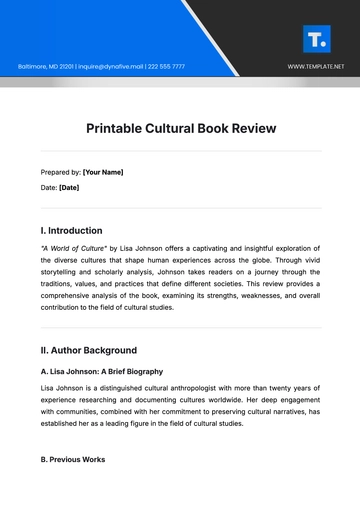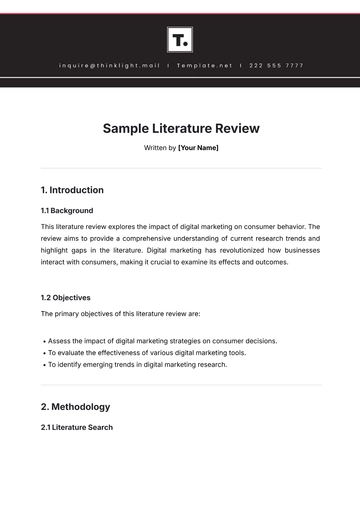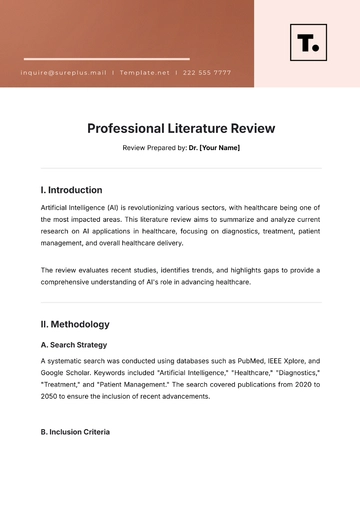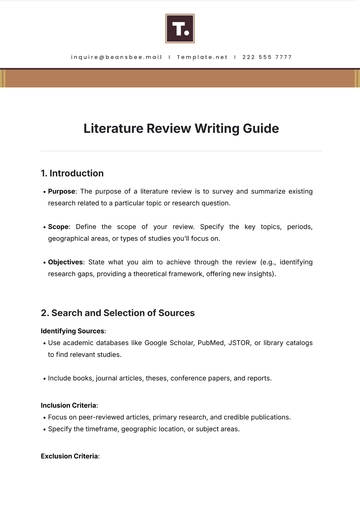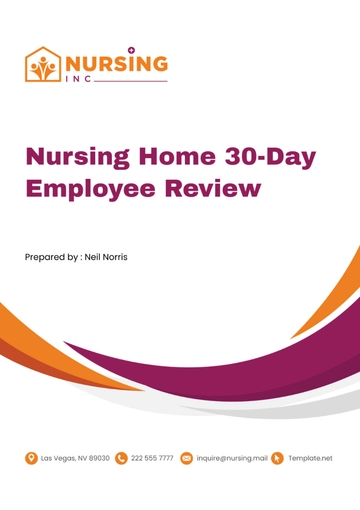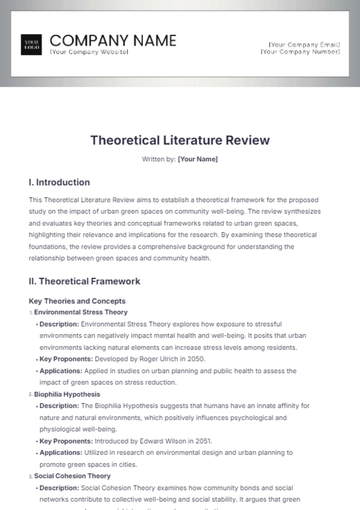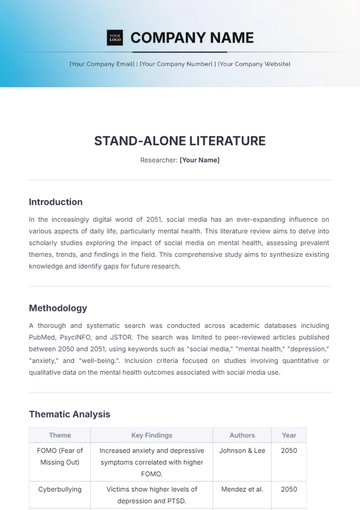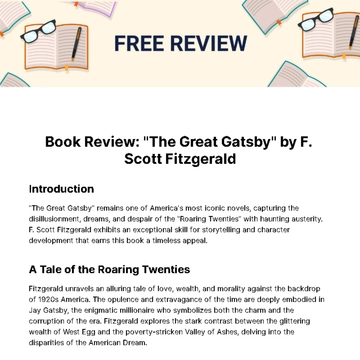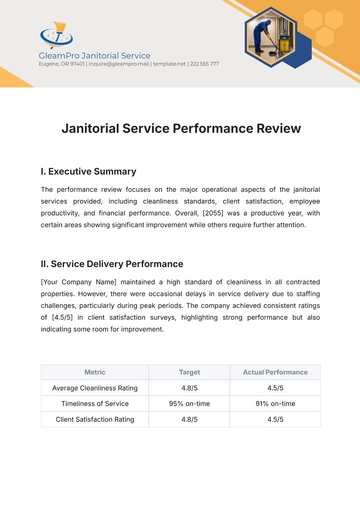Free Theoretical Literature Review
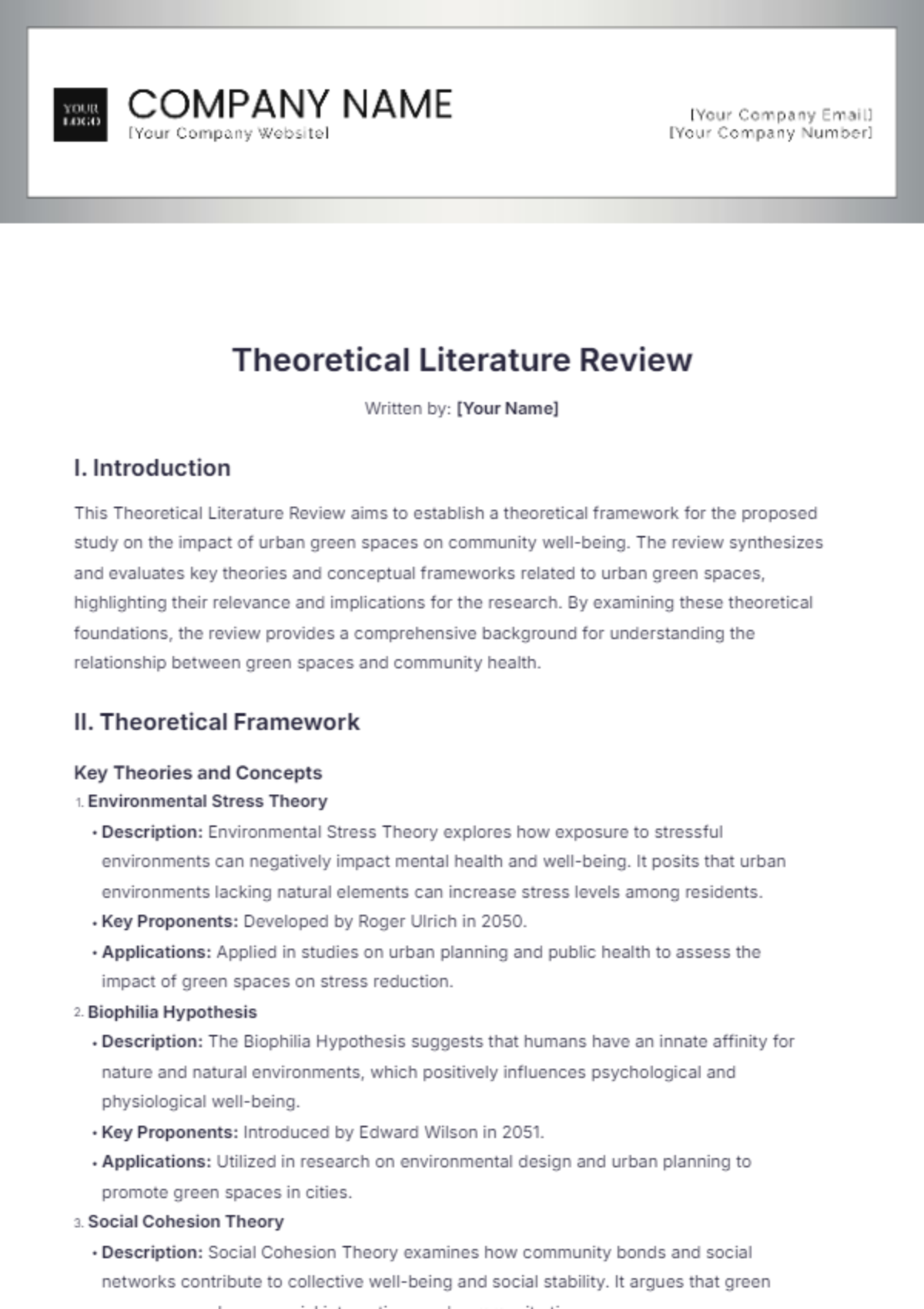
Written by: [Your Name]
I. Introduction
This Theoretical Literature Review aims to establish a theoretical framework for the proposed study on the impact of urban green spaces on community well-being. The review synthesizes and evaluates key theories and conceptual frameworks related to urban green spaces, highlighting their relevance and implications for the research. By examining these theoretical foundations, the review provides a comprehensive background for understanding the relationship between green spaces and community health.
II. Theoretical Framework
Key Theories and Concepts
Environmental Stress Theory
Description: Environmental Stress Theory explores how exposure to stressful environments can negatively impact mental health and well-being. It posits that urban environments lacking natural elements can increase stress levels among residents.
Key Proponents: Developed by Roger Ulrich in 2050.
Applications: Applied in studies on urban planning and public health to assess the impact of green spaces on stress reduction.
Biophilia Hypothesis
Description: The Biophilia Hypothesis suggests that humans have an innate affinity for nature and natural environments, which positively influences psychological and physiological well-being.
Key Proponents: Introduced by Edward Wilson in 2051.
Applications: Utilized in research on environmental design and urban planning to promote green spaces in cities.
Social Cohesion Theory
Description: Social Cohesion Theory examines how community bonds and social networks contribute to collective well-being and social stability. It argues that green spaces can enhance social interactions and community ties.
Key Proponents: Proposed by Robert Putnam in 2052.
Applications: Employed in studies on community development and urban sociology to explore the role of green spaces in fostering social connections.
Theoretical Evolution
Historical Development: Environmental Stress Theory has evolved from early studies on environmental psychology to its application in urban health research. The Biophilia Hypothesis has expanded from biological and psychological perspectives to influence urban design principles. Social Cohesion Theory has developed from initial sociological research to encompass aspects of urban planning and community development.
Integration of Theories: These theories are interrelated in understanding how green spaces can impact mental health, social interactions, and overall community well-being. For instance, the stress-reducing effects of green spaces (Environmental Stress Theory) complement the inherent human connection to nature (Biophilia Hypothesis) and support community bonding (Social Cohesion Theory).
Current Trends: Recent adaptations include integrating digital tools to measure and analyze the effects of green spaces and exploring their role in mitigating urban inequalities.
III. Literature Review
Summary of Existing Theories
Environmental Stress Theory:
Key Studies: Notable studies include Ulrich’s research on hospital environments (2050), a study by Kaplan and Kaplan on restorative environments (2051), and a recent study by Hartig et al. on urban parks and stress reduction (2052).
Findings: These studies demonstrate that exposure to green spaces can significantly reduce stress and improve mental health outcomes.
Biophilia Hypothesis:
Key Studies: Wilson’s foundational work (2051), a study by Kellert and Wilson on biophilic design (2053), and a recent investigation by Ryan et al. on biophilia in urban settings (2054).
Findings: Evidence supports the idea that incorporating natural elements into urban environments enhances psychological well-being and promotes healthier lifestyles.
Social Cohesion Theory:
Key Studies: Putnam’s research on social capital (2052), a study by Sampson et al. on community ties and green spaces (2055), and a recent analysis by Kawachi et al. on social cohesion and urban design (2056).
Findings: Green spaces are linked to increased social interactions, stronger community networks, and improved social cohesion.
Critique of Theoretical Approaches
Strengths and Weaknesses: Environmental Stress Theory effectively highlights the stress-reducing benefits of green spaces but may overlook other factors influencing mental health. The Biophilia Hypothesis provides a compelling rationale for the value of nature but needs further empirical validation in diverse urban contexts. Social Cohesion Theory offers valuable insights into community dynamics but may not fully account for the complexities of urban social networks.
Gaps and Inconsistencies: There is a need for more comprehensive studies that integrate these theories to address gaps in understanding how green spaces simultaneously impact stress, social interaction, and overall well-being. Additionally, more research is needed on the equitable distribution of green spaces in urban areas.
IV. Discussion
Relationships Between Theories
Comparative Analysis: Environmental Stress Theory, Biophilia Hypothesis, and Social Cohesion Theory collectively offer a holistic view of how green spaces affect urban populations. While each theory provides unique insights, their integration presents a more complete understanding of the multifaceted impact of green spaces on community well-being.
Theoretical Integration: Combining these theories can enhance urban planning practices by emphasizing not only the psychological and physiological benefits of green spaces but also their role in fostering community ties and social stability.
Implications for Proposed Study
Theoretical Contributions: The established framework will guide the proposed study by providing a comprehensive understanding of the theoretical mechanisms through which green spaces influence community well-being. It will help in designing research methods that address both individual and collective outcomes.
Future Research Directions: Future research should explore how different types of green spaces impact various demographic groups and assess the long-term effects of green space interventions on community well-being.
V. Conclusion
This Theoretical Literature Review has established a comprehensive theoretical framework for the proposed study on the impact of urban green spaces on community well-being. By synthesizing key theories and examining their interrelations, the review provides a solid foundation for further investigation. The insights gained will guide the research design and contribute to advancing knowledge in urban health and community development.
VI. References
Ulrich, R. (2050). Effects of Urban Green Spaces on Stress Reduction: A Longitudinal Study. Journal of Environmental Psychology.
Kaplan, R., & Kaplan, S. (2051). Restorative Environments: A Review of Theory and Research. Environmental Research and Design.
Hartig, T., et al. (2052). Urban Parks and Stress Reduction: Evidence from a Longitudinal Study. Journal of Urban Health.
Wilson, E. O. (2051). Biophilia: The Human Connection to Nature. Harvard University Press.
Kellert, S. R., & Wilson, E. O. (2053). The Biophilic Design of Urban Spaces. Urban Design Quarterly.
Ryan, R. L., et al. (2054). Biophilia in Urban Settings: A Meta-Analysis. Environmental Research Letters.
Putnam, R. D. (2052). Social Capital and Community Cohesion: The Role of Green Spaces. American Sociological Review.
Sampson, R. J., et al. (2055). Green Spaces and Social Ties: A Study of Urban Communities. Social Science & Medicine.
Kawachi, I., et al. (2056). Social Cohesion and Urban Design: The Impact of Green Spaces. Public Health Review.
- 100% Customizable, free editor
- Access 1 Million+ Templates, photo’s & graphics
- Download or share as a template
- Click and replace photos, graphics, text, backgrounds
- Resize, crop, AI write & more
- Access advanced editor
Streamline your research with the Theoretical Literature Review Template from Template.net. This fully editable and customizable tool, powered by the AI Editable Tool, allows you to tailor your literature review with ease. Perfect for academics and professionals, it simplifies the process, ensuring your work is both precise and polished. Start crafting effortlessly today.





